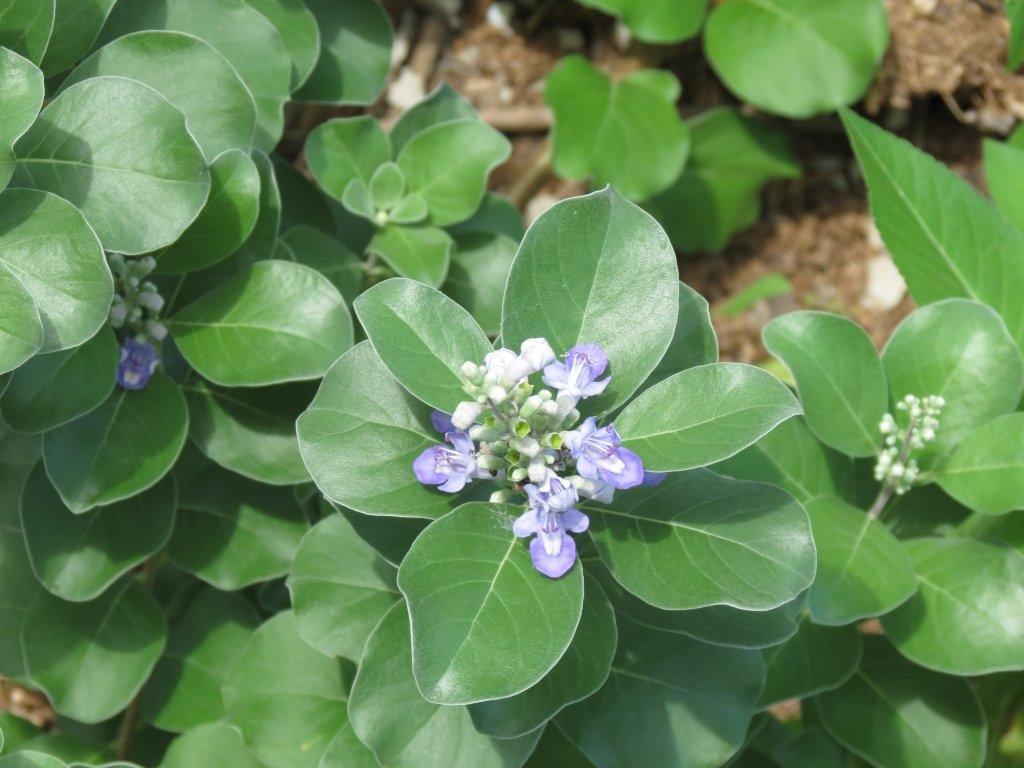
by Evan Anderson | May 20, 2020
Next week (May 18-22) is Florida Invasive Species Awareness Week! Join us online for an educational video each day at 9:00 am CST on invasive species that are important in our area and what to do about them. See the flyer below and join us on Facebook at https://www.facebook.com/PanhandleOutdoorsNews/ for the event!
Invasive species are living things that are not from an area and have adverse affects on people, whether it is their health, the economy, or the environment we live in. The more people who can identify and control these species, the healthier we can keep ourselves, our businesses, and the world around us!
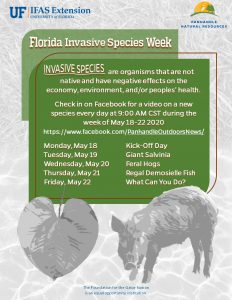

by Mary Salinas | May 14, 2020
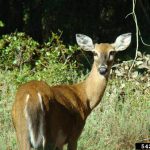
White tailed deer. Photo credit: Rebekah D. Wallace University of Georgia bugwood.org.
There doesn’t seem to be any shortage of deer in the panhandle, especially when it comes to them strolling in my yard looking for something tasty to eat. My vegetable garden suffered repeated assaults by hungry deer this past fall and winter. The garlic and cayenne pepper-based products only worked for a few days when freshly applied. I had to try something new this spring.
And my new method has worked. I purchased a motion activated high impact sprinkler that can be set to activate day or night. It has worked like a charm! There are various vendors but I purchased mine through a hardware store online for about $70. I put a splitter on my closest outdoor spigot and have a dedicated hose running to the sprinkler. This allows me to also have a regular hose for watering attached to the spigot. The hose must be turned on all the time. One problem that I am hoping to avoid this summer is that the water in the hose may get too hot in the summer heat and split the hose, so I am looking to maybe trench to keep the hose and the water inside a bit cooler.

Motion activated impact sprinkler protecting the vegetable garden from ravenous deer. Photo credit: Mary Salinas, UF/IFAS Extension.
You can also choose plants that deer do not like to eat such as live oak, dogwood, muhly grass, coneflower and black-eyed Susan. However, keep in mind that when food is scarce deer will forage on plants that they normally would not eat. Southern magnolia is considered quite deer resistant but the one I planted this past winter was mostly defoliated by deer.
The University of Florida has a publication with many other strategies on controlling deer: Coping with Deer Damage in Florida.
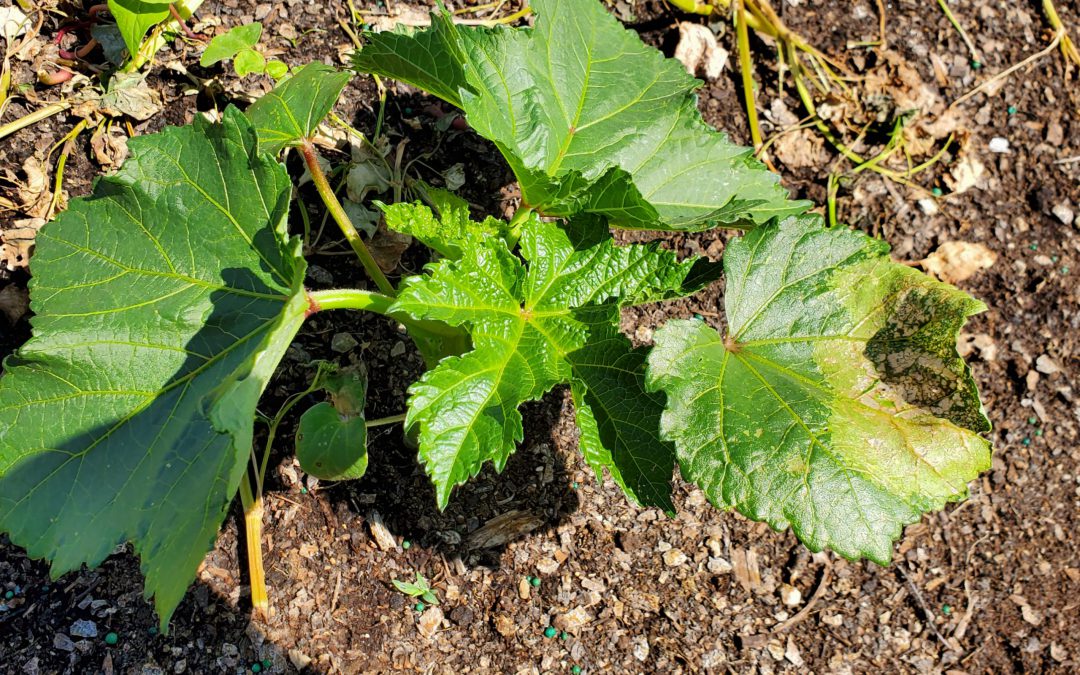
by Daniel J. Leonard | May 13, 2020
It’s been a challenging spring in this guy’s garden! Despite getting the normal early start required for successful gardening in Florida, I’ve been affected by Bacterial Leaf Spot stunting my tomatoes, cutworms that reduced my watermelon plantings by half, and an eternal test of my patience in the form of a dog that seems to think my raised beds are merely a shortcut to a destination further out in the yard. My latest adversary is the most potentially destructive yet, an outbreak of Southern Armyworm (Spodoptera eridania).
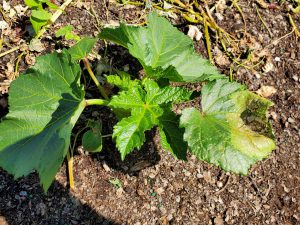
Early Southern Armyworm damage on Okra seedlings. Photo courtesy of the author.
Unlike some serious garden pests that wait until the heat of summer to emerge, Southern Armyworms begin appearing in spring gardens around the end of April. Adult moths can survive mildly cold weather and venture into the Panhandle as soon as warmer spring weather arrives. Once the adult moths arrive, egg masses are then laid on the undersides of leaves and hatch in a little under a week. Once loosed upon the world, Southern Armyworm larvae (caterpillars) become indiscriminate, voracious feeders and congregate in extremely large numbers, allowing them to destroy small, developing garden vegetable plants in a manner of days. Young larvae feed on the undersides of leaves and leave little but a skeleton. As larvae grow larger, they become solitary and begin to bore into fruit. Once they’ve eaten the good stuff (leaves and fruit), large larvae turn to branches and even plant stems!
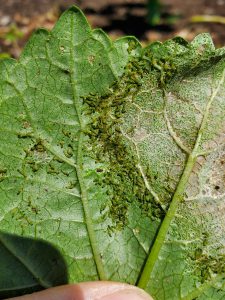
Southern Armyworm larvae feeding on Okra leaves. Photo courtesy of the author.
The good news for gardeners is that Southern Armyworm, and most other caterpillar pests, are easily controlled if outbreaks are caught early. Scouting is critical for early detection and good control. Armyworm damage generally appears from above as brownish-gray sections of affected leaves with a yellowish ring surrounding these sections, this ring indicates the current feeding zone. Affected areas will appear transparent and “lacy” due to the skeletonizing effects of larval feeding. If you see leaves that look “off” in the manner just described, check underneath for the presence of a horde of tiny greenish worms.
If found in this early stage, an application of Bacillus thuringiensis (Bt), a biological pesticide utilizing a bacterium destructive to caterpillars, is extremely effective. Bt has to be ingested by caterpillars with leaf tissue to work; thorough coverage of leaf surfaces is critical for maximum control. I generally follow up with a sequential application of Bt a day later to ensure that I achieved good coverage of the plant surfaces and, therefore, good control. Unfortunately, Bt is much less effective on older larvae. Infestations not caught early require harsher chemistries like carbamates, pyrethroids and organophosphates for adequate control.
Don’t let armyworms or other caterpillar pests destroy your garden, get out there daily and scout! You have a short window for easy caterpillar control with a harmless to people, natural product, Bt. Don’t waste it!
For more information about Southern Armyworm, other caterpillar pests, Bt, or any other horticultural topic, please consult your local UF/IFAS Extension Agent. Happy Gardening!

by Daniel J. Leonard | Apr 29, 2020

‘Multipik’ fruit. Photo courtesy the author.
Never one to be satisfied growing “standard” vegetable varieties, last year I decided to peruse various seed sources in search of a superior yellow summer squash selection. Plain ‘Yellow Crookneck’ just wasn’t doing it for me anymore. After doing a little research and consulting a friend who works for Johnny’s Selected Seeds, I settled on a straightneck variety called ‘Multipik’.
Developed in the 1980’s by Harris Seed and now sold by many seed purveyors, ‘Multipik’ enjoyed immediate popularity with commercial squash growers due to its many outstanding qualities but curiously, is just making inroads with the home garden market. Even as it is set to celebrate its 30th anniversary next year, two years of personal experience with ‘Multipik’ verify several important characteristics making it a superior choice to many other traditional summer squash varieties: earliness/heavy yields and a precocious gene.
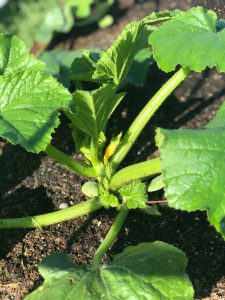
Newly developing ‘Multipik’ fruit. 4 weeks after planting. Photo courtesy the author.
The longer I garden, the more I’m convinced that earliness to maturity is directly related to yield potential in home gardens, especially in the Panhandle. Lots of varieties have high yield potential but that potential is often at least partially wasted here due to the length of time from seed to harvest. Ideally, you could plant, grow a crop and be done by mid-late June, before intense heat, humidity and all the wonderful garden pests and diseases arrive to destroy spring gardens. Maturing just 50 days from planting, ‘Multipik’ beats that deadline (when planted on time in late March) and yields heavily for at least a month before succumbing to the harsh Panhandle summer. Many traditional summer squash varieties, including ‘Yellow Crookneck’ mature 8-14 days later. While 8-14 days doesn’t sound like much, it can mean a major yield difference when factoring in the almost certain late season pests, diseases, and adverse weather conditions.
The next major advantage ‘Multipik’ offers is a precocious gene, meaning that it will mask symptoms and maintain its yellow color if infected with either Watermelon Mosaic Virus (WMV) or Cucumber Mosaic Virus (CMV), two destructive pathogens commonly affecting squash by discoloring fruit and reducing yield. This trait is critical to commercial growers because yellow squash that isn’t yellow isn’t marketable and is important to home gardeners too as a means to eke out higher yields under virus pressure. While the precocious gene isn’t a cure for either virus, it can help hold them at bay while you harvest! Another quirk caused by the precocious gene is the all-yellow appearance of the fruit, from the peduncle (the stalk holding the fruit to the plant) to the apex! From one end of the fruit to the other, Multipik ensures that when you plant yellow squash, you harvest yellow squash.
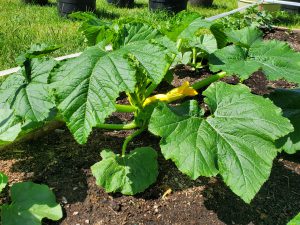
‘Multipik’ just days from harvest. Photo courtesy the author.
Whether you are trying to avoid yield loss from late season insect and disease pressure plaguing your traditional squash plantings or just want to try something a little different, I highly recommend planting ‘Multipik’ Squash. This early, disease-resistant cultivar with delicious medium sized, light yellow fruit is sure to be a hit in both in the garden and on the table. As always, if you have any questions about vegetable gardening or any other horticultural topic, give your local UF/IFAS County Extension Office a call! Happy gardening!

by Larry Williams | Apr 29, 2020
In times like these, it seems that our own perceived “problems” pale in comparison to the “big picture.” In my day-to-day work, I have the opportunity to help people solve problems with their landscapes, lawns and gardens. I enjoy the problem solving part of my job as an extension agent.
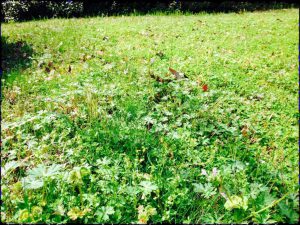
Winter annual weeds in lawn in early spring. Photo credit: Larry Williams
You’d be surprised how upset some people can be about a few weeds, a dying petunia or a tomato with a crack in it. They’ll let small things like this upset their entire world. It’s as if they think we live in a perfect world when it comes to expectations for the plants in their own landscape.
It has become apparent to me that too many people spend too much time letting too many small things bother them too much.
When my twin sister, Linda, and I were growing up in a small town in middle Georgia, an elderly couple (Mr. and Mrs. Hunt) would crack pecans and give the shelled halves to us to eat. They’d hand the shelled pecans to us over the fence that separated our yards. At five or six years old this was a treat for my sister and me.
I remember their landscape. I remember Mrs. Hunt sweeping their dirt driveway lined with coconut sized rocks. She used handmade brooms. I remember their pink flowering dogwoods in spring. I remember their old-fashioned yellow and orange daylilies during summer. I remember the fascination of seeing red spider lilies seemingly come from nowhere in the fall underneath deciduous trees as they displayed their autumn colors. I remember Mrs. Hunt letting me smell a flower from a sweetshrub plant, which reminded me of sweet apples. The deep red blooms and dark green leaves of this shrub complemented the white wooden wall on the east side of their home.
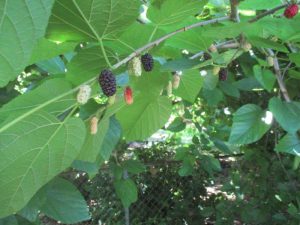
Mulberry tree with fruit. Photo credit: Larry Williams
I remember climbing a large mulberry tree in their backyard and picking and eating the berries. I remember watching Mr. Hunt prune grapevines growing on an overhead trellis. I remember learning about the history of a ginkgo tree planted just outside a chicken pin in their side yard. I remember watching hummingbirds flying in and out of the reddish orange funnel-shaped blooms of a large trumpet vine growing on an old metal frame of a water tank.
I don’t remember the weeds, even though I know there must have been weeds in the Hunt’s landscape. I know there was the occasional pecan that didn’t fill out or that was worm infested. And I’m sure an occasional plant had to be replaced. But these are not the things that made lasting impressions for me.
The big picture is not the weeds, the dying petunia plant or the pecan with a worm in it. Sure you will have weeds in your yard and certain plants that don’t survive. Just don’t let these things become the source of worry. In my opinion, a landscape should be a source of pleasure, a place to learn and a place to pass along lasting memories. Besides, with all the things there are to worry about in this world (as recent days have revealed), why let your own backyard be one of them?
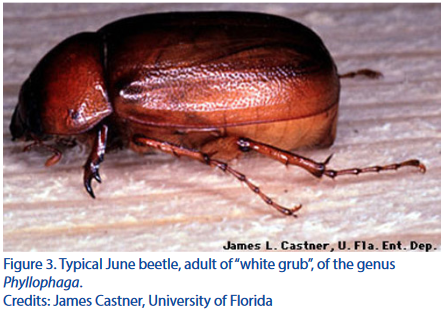
by Sheila Dunning | Apr 23, 2020
Members of the Phyllophaga genus are found throughout Florida and most of North America. One of them is the May/June beetle. Adults are most active during the rainy season. So in parts of the country where the wetter months are May or June, the common name of this insect makes common sense. But, when an area experiences extra rain earlier in the spring, the May/June beetle may emerge from the ground in March or April. That is what has happened in the western Panhandle this spring. May/June beetles have been leaving the soil and flying to the lights of people’s homes.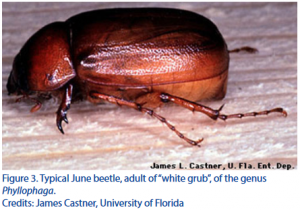
The life cycle of these beetles varies from one to four years. Eggs are laid in soil each spring by females. In 3 to 4 weeks, small grubs (larvae) hatch from eggs and develop through three stages (instars), with the first two stages lasting about 3 weeks. The larvae will move closer to the surface and back deeper in the soil as the soil temperature changes. While close to the surface, larvae feed on grass roots about one inch below the soil surface. Damaged grass turns brown and increases in size over time. Heavy infested turf feels spongy and moves when walked upon. The last larval stage remains in the soil from the fall through spring. The cool soil temperatures drive the larvae deeper in the soil where they remain relatively inactive. Typically, on the third year, white grubs pupate 3 to 6 inches deep in the soil and emerge as adults.
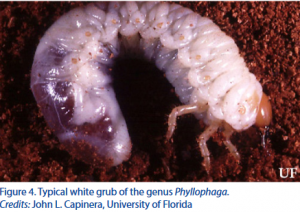 Larvae, called grubs, vary in length from ¾ to 1 ¾ inches depending on the stages. Grubs are white with a C-shaped body with a brown head and three pairs of legs near the head. Adults have ½ to 1 inch long, shiny bodies that are dark yellow to brownish-red in color. Adults do feed on the foliage of several species of ornamental plants, but the damage is typically only aesthetic; not causing long-term harm.
Larvae, called grubs, vary in length from ¾ to 1 ¾ inches depending on the stages. Grubs are white with a C-shaped body with a brown head and three pairs of legs near the head. Adults have ½ to 1 inch long, shiny bodies that are dark yellow to brownish-red in color. Adults do feed on the foliage of several species of ornamental plants, but the damage is typically only aesthetic; not causing long-term harm.
Monitoring of and managing emerging adults can help with deciding on the need for insecticide control for the grubs. To catch and remove adult beetles, place white buckets containing soapy water near plants that have chew marks or areas with lights at night. Leave it overnight. The beetles can easily be disposed of the next day. If there are more than 12 in the bucket be prepared to monitor the lawn for grubs. Extra rain or frequent irrigation during the adult flight time may attract more egg-laying females.
To inspect for grubs, turn over sod to a depth of at least two-inches. If there are an average of three or more per square foot, an insecticide treatment may be needed. To confirm that they are May/June beetles inspect the darkened rear of the grub. Locate the anal slit. It should be Y-shaped with two rows of parallel bristles that point toward each other. This is referred to as the raster pattern. All grub species can be identified using their unique “butt” features.
The most effective time to control this pest is summer or early fall when the larvae are small. Remove as much thatch as possible before applying an insecticide. Spot treat the off-colored area plus the surrounding 10 feet with products containing imidacloprid or halofenozide in early summer. Follow up in the fall with insecticides such as trichlorfon, bifenthrin or carbaryl if grubs persist.


















